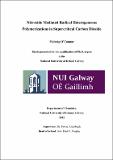| dc.description.abstract | Chapter 1 provides a general introduction to addition radical polymerizations and controlled/living radical polymerizations with an emphasis on nitroxide-mediated polymerization (NMP). The merits of supercritical carbon dioxide (scCO2) as a polymerization medium are described, focusing on heterogeneous NMP systems.
Chapter 2 describes the work published in, Macromolecules 2009, 43, 914-919. The point of particle nucleation or the critical degree of polymerization (Jcrit) at which polymer chains become insoluble in the continuous medium (scCO2) has been ascertained under a variety of experimental conditions for the precipitation NMP of styrene (St) and tert-butyl acrylate (t-BA), mediated by SG1. A simple graphical model has been developed and successfully employed, whereby Jcrit can be predicted as a function of both target molecular weight and initial monomer loading. Jcrit is shown to increase linearly with increasing pressure.
Chapter 3 details the work published in, J. Polym. Sci. Part A: Polym. Chem. 2011, 49, 1856-1864. Chain transfer to solvent has been investigated in the conventional radical polymerization (RP) and NMP of N-isopropylacrylamide (NIPAM) in N,N-dimethylformamide (DMF) at 120 °C. The same chain transfer to solvent constant (Ctr,S) can account for the deviation of experimental molecular weight data from theoretical, in both conventional RP and NMP.
Chapter 4 gives an account of the work published in, J. Polym. Sci. Part A Polym. Chem. 2011, 49, 1719-1723. The first controlled/living inverse suspension polymerization in scCO2 is described. The NMP of NIPAM proceeded in the absence of stabilizer to high conversion with low polydispersity, affording a dry powder. The purification step entails washing with fresh scCO2, and the technique thus completely avoids of the use of environmentally damaging volatile organic compounds.
Chapter 5 presents the work published in, Eur. Poly. J. 2012, doi.org/10.1016/j.eurpolymj.2012.04.011. A new preparation of thermoresponsive poly(NIPAM) containing block copolymers, involving two successive heterogeneous controlled/living NMPs in scCO2 is described. Precipitation NMPs in scCO2 give functionalised macroinitiators (MIs), and a first report of the controlled/living NMP of N,N-dimethylacrylamide in scCO2 is described. The MI initiates an inverse suspension NMP of NIPAM in scCO2. Aqueous cloud point temperature analysis for AB block copolymers show a significant dependence on poly(NIPAM) chain length. | en_US |


